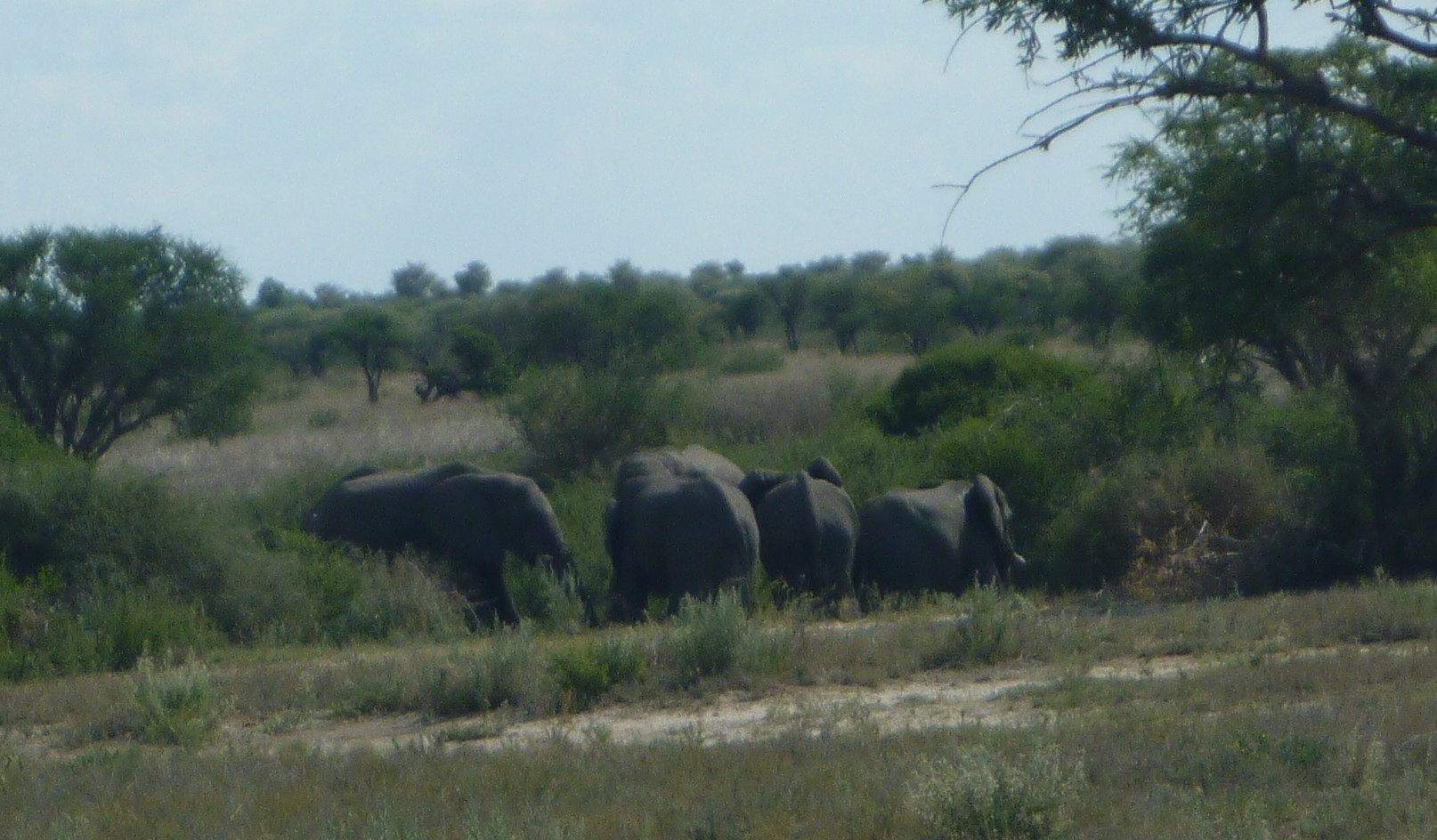The converging game paths have been hinting at a waterhole somewhere ahead all afternoon. It turned out to be an unexpected black basalt basin in the endless sand veldt, about the size of a suburban home. I filled my water containers and moved away a bit and found a generous tree to sleep under, far enough from the pool so that I would not disturb visiting animals.
As the sun began to stretch the shadows eastwards, this bull herd came gently swaying out of the thornveld in single file. I was downwind from them so they were unaware of me. When I thought my camp would get me through the night in reasonable comfort and safety, I took my binoculars and moved closer to watch them for a bit.
There were eight of them of various ages. A typical bachelor herd. Two youngsters had clearly just recently been given their marching orders from their maternal herds by the matriarch in charge; two were senior bulls, and the others fitted somewhere in between. All had decided that male company was better than wandering the trackless bush alone.
They were taking their time at the pool, drinking, spraying themselves, splashing around – the rocky basin unfortunately did not offer mud-baths, so grunting, squealing and rumbling had to make up for it. It was quite a boisterous affair.
The pool could only accommodate maybe three or four at a time and it was clear that an established hierarchy was strongly insisted on for who was allowed in and when – much more severe than would have been the case had it been a herd of cows, was my observation.
This is actually a good illustration of quite typical elephant behaviour.
The bull in the centre with just his back visible above the others was the senior. He considered only one other, the one on the left, to be of sufficient status to join him in the pool. The three bulls to the centre-right, although adult or almost adult, had to wait on the edge. The other three lowest-ranked were even further back among the trees. They waited patiently in the shade, engaging in some leisurely male companionship by touching each other with their trunks and ears and maybe grunting at frequencies I couldn’t hear.
Once the two seniors felt they had indulged themselves enough, they nonchalantly moved out and started dusting themselves on the edge of the pool. The Gang of Three went in together, but even among them there was a strict hierarchy, which the more dominant constantly and bluntly kept the lesser ones aware of by curling of the trunk or laying back of the ears or thrusting out the head, to more blunt shaking with ears and trunk flapping.
The last three, younger and about equally-aged, had in the meantime moved up. They were all allowed in after a bit, with the largest of the Gang of Three still in the water. The scene now became less settled. The youngsters were livelier, but it was as if they were constantly in trouble for some infringement of elephant behaviour code – such as coming too close, or being in the way, or maybe just displaying a hint of insubordination – and the big one let them know with head tossing and trunk waving that it was not to be tolerated. When the bigger bull finally left too, and the three youngsters were alone, things got a lot more rowdy, with jostling and splashing and generally messing up the water. I was glad I had already filled my containers. The water wasn’t very clean then, but now it would be closer to elephant dung soup!
Elephant breeding herds are close-knit family groups, made up of a matriarch, who is the most experienced and the leader, and her sisters, daughters, nieces and nephews. Adult males are seldom seen with them – usually only when one of the females is in oestrous or when a male in musth happens on them and tries to convince one to come into oestrous.
The nephews, when they start taking an interest in their aunts and nieces from around twelve-plus years old, are pushed out of the group by the matriarch, if they had not already left of their own accord. The young bulls often hang around in the vicinity of their family, but eventually wander off. They may roam around on their own but will, at least from time to time, join with groups of other bulls. These groups are made up of various ages. Associations are loose and bulls join and leave all the time. More lasting bull associations are not uncommon though, especially between old bulls. These would often form groups of two to four that would stay together for years. It is in these bull herds, through bull-to-bull interaction that the younger bulls learn their place and manners in elephant society, and this is extremely important for wider elephant fellowship and, with such huge members, for wider bush fellowship.


I love how you can sit and keenly observe a herd of elephant, undisturbed for hours. What a privilege! It’s as if time was standing still… Quite a rare occurrence in this day and age.
Your writing often leaves behind a sense of tranquillity that’s hard to come by in this ruthless chase that we call life. Thanks for sharing :)